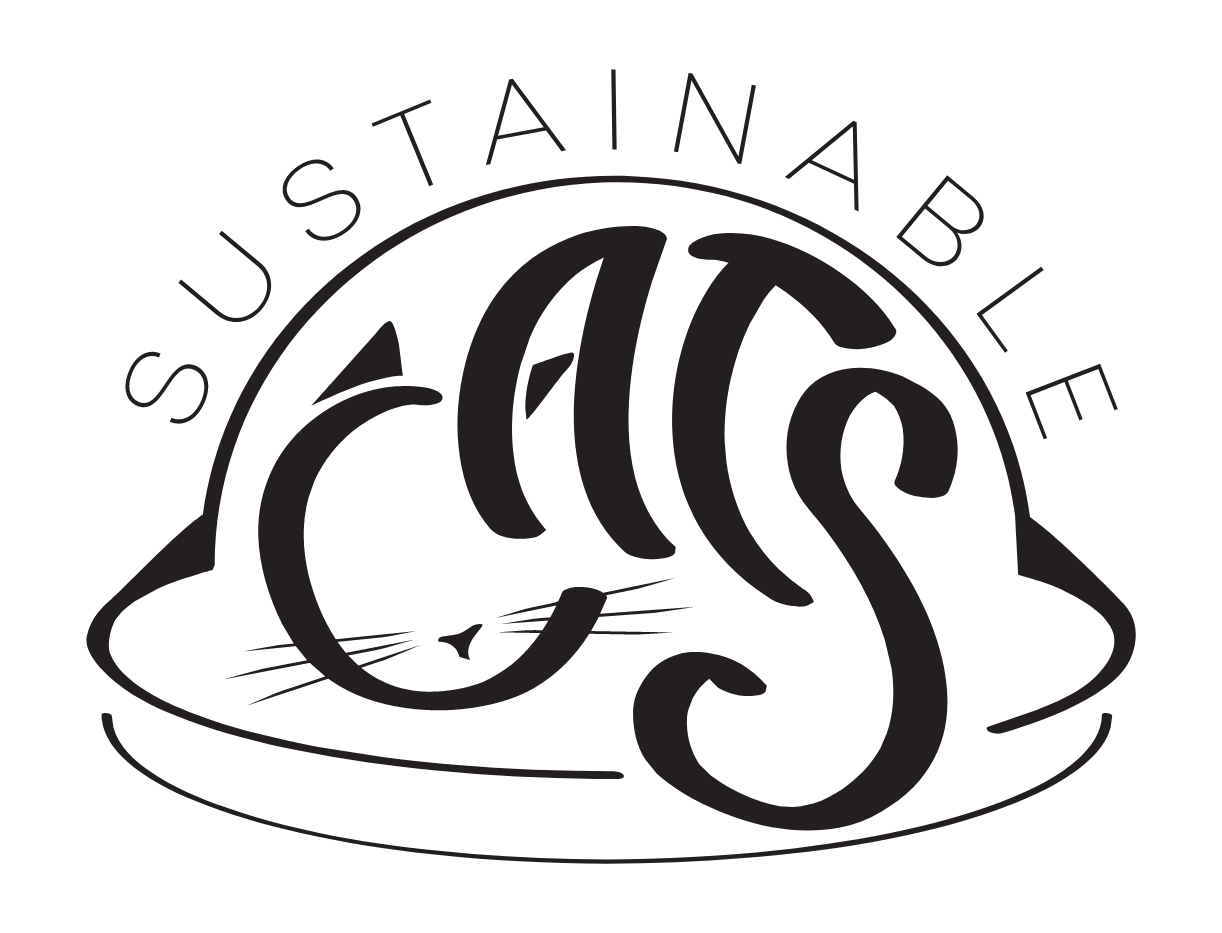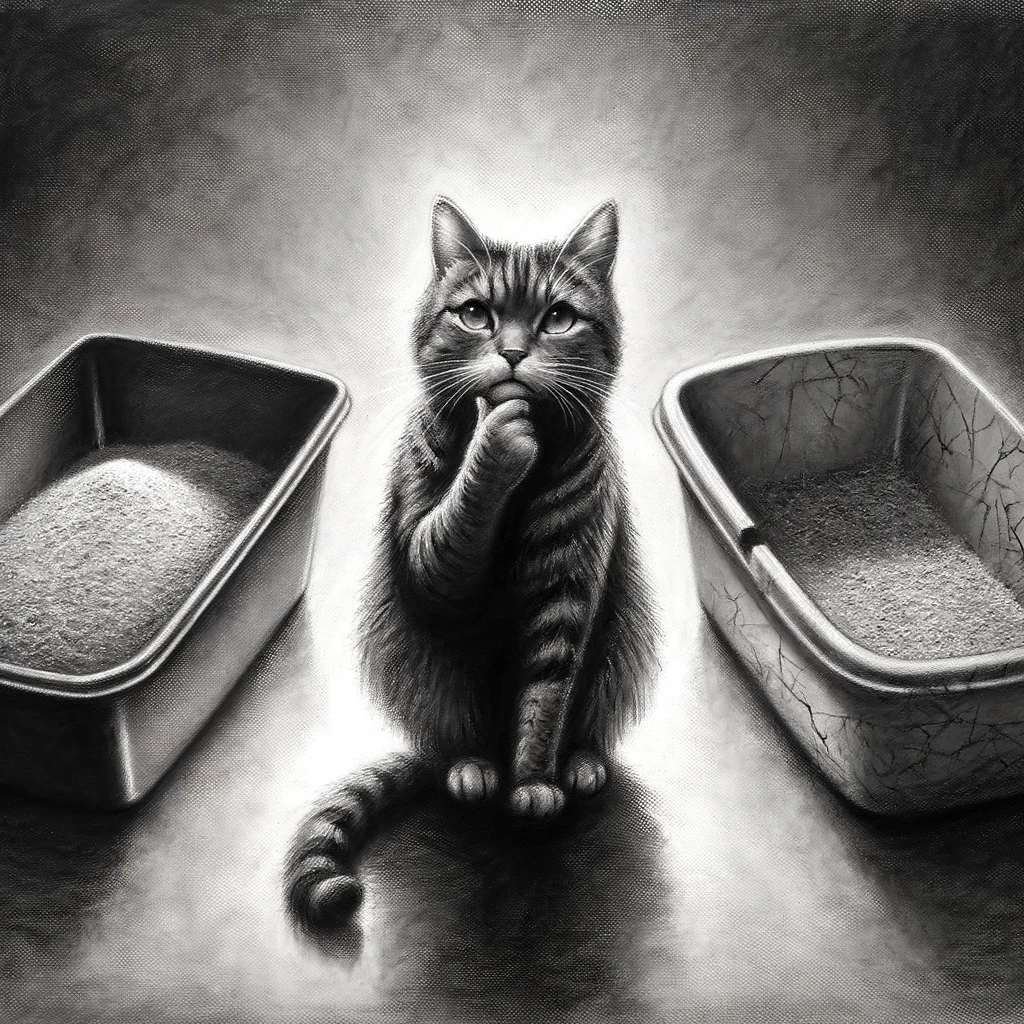Stainless Steel vs Plastic. What is the best material for a litter box?
As a responsible cat owner, it is crucial to make an informed decision to ensure the comfort and well-being of your feline friend.
It’s important to note that the choice of material for a litter box has implications beyond just the cat’s preference. Factors like durability, hygiene, and environmental sustainability must also be considered.
In recent years, there has been growing awareness and concern about the environmental impact of our choices, even when it comes to our furry friends. When selecting a litter box material for your cat, it is crucial to consider both durability and environmental sustainability.
Stainless steel litter boxes are popular for many cat owners due to their durability and long lifespan. Made from a sturdy and corrosion-resistant material, stainless steel litter boxes are built to withstand the test of time. They are less likely to develop cracks or leaks, ensuring they can be used for years without frequent replacements.
Not only are stainless steel litter boxes durable, but they also offer several hygienic benefits. The smooth surface of stainless steel makes it easier to clean and disinfect, reducing the risk of bacterial buildup and odour. Additionally, stainless steel is non-porous and less likely to absorb unpleasant smells or stains over time.
While stainless steel litter boxes have many advantages, we must also consider their environmental impact. Stainless steel is highly recyclable, making it a more sustainable choice than plastic. By choosing a stainless steel litter box, you can contribute to reducing plastic waste and promote a more eco-friendly lifestyle.
On the other hand, plastic litter boxes remain a popular option due to their affordability and wide availability. However, it is essential to note that plastic litter boxes have a shorter lifespan and are prone to cracking or breaking over time. This may result in the need for frequent replacements and ultimately contribute to more waste in landfills.
Furthermore, plastic is a petroleum-based material, which means it is derived from non-renewable fossil fuels. The production of plastic litter boxes involves consuming natural resources and releasing greenhouse gases, contributing to environmental degradation. Plastic waste also poses a significant problem, as it can take hundreds of years to decompose, causing harm to wildlife and ecosystems.
In light of these considerations, it is clear that stainless steel litter boxes offer a more durable and environmentally sustainable choice for cat owners. Their long lifespan, easy maintenance, and recyclability make them an excellent option for those seeking to reduce their environmental footprint while providing a hygienic and comfortable space for their feline companions. So, when it comes to selecting a litter box material, why not choose stainless steel and make a positive impact on both your cat’s well-being and the planet?
Durability Matters
When evaluating litter box options for feline companions, one must consider the longevity imparted by the material’s intrinsic qualities. Stainless steel, with its robust construction and resistance to corrosion, stands as a paragon of durability, enduring rigorous daily use with minimal wear. In contrast, plastic litter boxes may degrade over time, falling victim to scratches that harbour bacteria and odours and can crack under stress, necessitating more frequent replacements. The longevity of a stainless steel litter box reflects its resilience to constant scratching and cleaning. It signifies a waste reduction and costs over time, underpinning its status as a superior choice for the eco-conscious pet owner.
Longevity of Stainless Steel
Stainless steel boasts remarkable durability—it is designed to withstand years of use without diminishing quality or performance.
Due to its non-porous nature, stainless steel effectively repels lingering odours and resists the abrasive effects of cat claws, thereby maintaining its integrity over an extended period.
Superior longevity means fewer replacements and decreased environmental impact—a testament to stainless steel’s eco-friendly advantage in pet care products.
Plastic’s Potential for Wear and Tear
Plastic litter boxes are not immune to the effects of continuous scratching and exposure to urine.
- Absorption of odours due to plastic’s porous nature
- Scratches and grooves form quickly, harbouring bacteria and waste
- Degradation from cleaners accelerates wear
- Susceptibility to cracks or breaks under the stress of daily use or during cleaning
- Staining from waste and cleaning agents
These factors necessitate regular replacement, impacting both cost and environmental sustainability.
Over time, the integrity of a plastic litter box is compromised, reducing its utility and safety for your feline companion.
Health and Hygiene Factors
When selecting a litter box, the health and hygiene of your feline companion must be a priority. Stainless steel offers a non-porous surface, inhibiting bacteria from seeping into crevices and drastically reducing potential health risks such as bacterial infections from contaminated boxes. The waterproof nature of stainless steel to stains and odours also ensures a cleaner and more hygienic environment for the cat and the owner. Plastic, by contrast, can harbour bacteria in scratches and absorb odours, presenting less optimal sanitary conditions. Thus, from a hygienic standpoint, stainless steel is the superior choice, providing a safer and cleaner space for your cat’s daily needs.
Ease of Sanitizing Stainless Steel
Stainless steel’s surface repels microbial growth, offering a more sanitary option than plastic, which can become etched over time, compromising its cleanliness. This attribute establishes stainless steel as a material conducive to maintaining a pure and uncontaminated environment for your pet.
The non-porous nature of stainless steel makes it resistant to pathogenic colonisation. Consequently, cleaning routines are significantly more straightforward and effective.
Significantly, stainless steel does not deteriorate with the repeated use of harsh disinfectants, unlike plastic alternatives (which may degrade when exposed to specific chemicals) and remains resilient.
Easy to sterilise, stainless steel withstands boiling water and steam cleaning without sustaining damage or deforming, ensuring the hygiene standard is uncompromised.
Moreover, without worrying about the absorption or retention of liquids and waste, stainless steel reduces the risk of feline contamination. This is particularly pertinent in multi-cat households or shelter settings where cross-contamination could pose a serious health concern.
Finally, the longevity of stainless steel’s surface allows for sustained sanitation over time, fostering consistently clean conditions that support your cat’s health and wellbeing. This endurance translates into fewer replacements and a more stable long-term hygiene solution.
Plastic: Bacteria and Odor Risks
Plastic litter boxes may harbour harmful bacteria.
Over time, plastic materials can develop scratches. These micro-abrasions become sanctuaries for bacteria which can resist standard cleaning procedures. Once embedded, bacteria proliferate, emitting malodors and increasing the potential for feline urinary infections. Consequently, plastic can become a silent vector of contamination and discomfort for your cat.
The porous nature of plastic enables odour retention.
Due to susceptibility to scratches, plastic – if not meticulously maintained – supports pathogen entrenchment. Regular cleansing might seem sufficient at the surface level, but bacteria trapped within micro-abrasions persist, jeopardising the healthy environment.
Odour molecules attach tightly to plastic surfaces.
These tenacious microorganisms in plastic necessitate vigilant cleansing protocols to mitigate persistent odours and bacterial contamination, often demanding harsher chemicals which can compromise the plastic’s integrity. This underscores the importance of selecting a material that inherently minimises bacterial adherence and odour preservation within the litter box domain.

The Microplastics Big Problem
Microplastics spawn significant environmental issues.
When considering cat litter boxes, the impact extends beyond immediate functionality; plastics fragment into tiny particles, contributing to the vast arrays of microplastics pervading our water systems, soils, and even the air we breathe. Durable, biologically inactive materials like stainless steel present a more ecologically sound alternative, preventing this insidious form of pollution.
Each plastic box is a potential microplastic source.
Microscopic abrasions in plastic degrade into microplastics.
The prevalent use of plastics contributes to worldwide microplastic pollution.
The call for sustainable cat ownership demands addressing the ramifications of microplastic pollution. Opting for a stainless steel litter box would align with eco-conscious practices, exemplified by the material’s recyclability and lack of contribution to the troubling microplastic dilemma. By the close of 2023, embracing such solutions should be paramount in our joint endeavours for sustainable pet care.
Environmental Considerations
Plastic litter boxes, predominantly derived from non-renewable petroleum-based polymers, possess an inherent environmental liability that spans their entire lifecycle—from extraction to eventual disposal. The ecological footprint of this plastic manufacturing process is substantial, contributing to greenhouse gas emissions and depletion of finite resources. Meanwhile, stainless steel’s footprint is mitigated by its longevity and almost infinite recyclability, reducing waste and conserving resources in the long term.
When evaluating end-of-life scenarios, plastic presents significant issues in waste management. Not all plastic litter boxes are recyclable and are often left in landfills due to contamination or lack of recycling infrastructure. In contrast, stainless steel boasts a higher recycling rate, with its valuable properties prompting efficient reintegration into the production cycle, markedly reducing its long-term environmental impact.
Sustainable cat ownership requires a conscious decision to minimise resource depletion and waste. By choosing a stainless steel cat litter box, one joins a growing contingent of eco-conscious pet owners championing sustainable materials, thus promoting a more harmonious relationship between our pet care practices and the planet’s ecosystems.
Stainless Steel’s Recyclability
Stainless steel is distinguished by its exceptional capability for recycling, often cited as a cradle-to-cradle material. Its lifecycle is characterised by efficient reusability without degradation in quality, making it a sustainable choice for environmentally conscious cat owners.
Over 60% of new stainless steel comes from remelted steel scrap, drastically reducing the demand for virgin raw materials. This process conservatively uses energy, further underlining stainless steel’s environmentally favourable profile compared to plastic alternatives.
The inherent value of stainless steel scrap incentivises a robust recycling infrastructure, ensuring materials are reprocessed and not lost to landfills. Stainless steel’s high recovery rate is a testament to the material’s prominence in sustainability circles and its alignment with circular economy principles.
Recycling stainless steel also reduces carbon emissions, as producing new metal from recycled materials consumes considerably less energy than forging it from raw ore. Hence, purchasing a stainless steel cat litter box significantly contributes to reduced greenhouse gas emissions.
Encouragingly, once a stainless steel cat litter box reaches the end of its service life, it enters a well-established circular pathway. There, it is infinitely recyclable, perpetuating its use without sacrificing performance or ecological integrity.
Plastic Pollution Concern
The predominance of plastic waste is a pressing ecological quandary that significantly impacts marine and terrestrial ecosystems.
- Endurance of Plastic Waste: Unlike biodegradable materials, plastic can persist in the environment for centuries, exacerbating pollution.
- Wildlife Endangerment: Ingestion and entanglement in plastic debris continually menace wildlife, often leading to fatal outcomes.
- Microplastics Proliferation: Plastic litter degrades into microplastics, polluting water sources and entering food chains at alarming rates.
- Chemical Leaching: Over time, plastic litter can release harmful chemicals into the environment, posing a risk to ecological and human health.
- Recycling Limitations: Although recycling provides a mitigation pathway, not all plastics are recyclable, and many end up in landfills or the natural environment. Recycled plastics are often of inferior quality, which limits their use and eventually leads to disposal issues. A shift towards sustainable materials like stainless steel in cat litter box production could alleviate the expanding plastic pollution footprint.
The Comfort and Preference Factor
Cats exhibit distinct behaviours and preferences which transcend their selection of litter boxes. The texture and resilience of stainless steel offer a tactile sensation that is more appealing to some felines than plastic varieties. In contrast, others might favour plastic’s slight give and warmer touch. Consider these nuances to ensure comfort, which, in turn, may lead to better usage consistency.
The auditory experience associated with using a litter box also influences feline preference. Cats may find the softer litter sound against plastic less intimidating than the sharper noises produced when interacting with stainless steel. Attention to these sensory details is vital in cultivating an environment that aligns with your cat’s natural inclinations and ensures their well-being.
Feline Reactions to Materials
Cats possess an acute sense of touch, influencing their interactions with different litter box materials. The texture and temperature of the box’s surface can significantly impact their comfort and willingness to use the provided facilities.
Since 2016, scholarly research has supported the idea that cats have material preferences, suggesting that the material composition of a litter box may impact their stress levels and bathroom habits. Findings imply that cats engage more comfortably with materials that do not conflict with their sensitive tactile perceptions.
Moreover, cats’ olfactory senses are exceptionally delicate, leading to preferences for materials that do not retain or amplify odours. Stainless steel’s non-porous nature ensures that it doesn’t harbour smells the way plastics can, potentially reducing feline aversion and litter box avoidance.
Additionally, the susceptibility of materials to static buildup can affect feline comfort. While plastic litter trays may generate static, potentially clinging to fur, stainless steel alternatives remain static-free, enhancing the litter box experience for your cat.
Caring for the environmental compatibility of your cat’s litter box also includes considering the animal’s innate responses to material choices. The well-being of your feline friend is paramount in maintaining a sustainable and harmonious home ecosystem.
Owners’ Aesthetic and Handling Preferences
A cat litter box should integrate seamlessly into your home environment and daily routine.
- Design appeal: Stainless steel boasts a sleek, modern aesthetic compared to plastic.
- Weight considerations: Stainless steel may be heavier, affecting portability.
- Noise factor: Plastic boxes are typically quieter when being moved or handled.
- Durability: Stainless steel resists scratches and dents that plastic boxes may incur.
- Long-term value: Considering durability and longevity, stainless steel may offer better cost efficiency.
To conclude, stainless steel litter boxes are a fantastic option for cat owners looking for a long-lasting, eco-friendly, and durable litter box. They are easy to clean and help reduce plastic waste. They are also resistant to odours, making them an ideal choice for any household.
Additionally, they are stylish and modern, making them a great addition to any home decor.
Consider investing in a stainless steel litter box for your cat today and enjoy the many benefits that come with it.











One thought on “Stainless Steel vs Plastic: Choosing the Best Cat Litter Box”